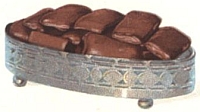
| Chocolates, Truffles, Candies, Confections | ||
Almond Chocolate Bars
Melt the sugar in the water and glucose and let boil to about 252° F., or between a soft and a hard ball. Without the paraffine cook a little higher than with it. Add the almonds and the vanilla, mix thoroughly and turn onto a marble or platter over which powdered sugar has been sifted. Turn out the candy in such a way that it will take a rectangular shape on the marble. When cool enough score it in strips about an inch and a quarter wide, and, as it grows cooler, lift the strips, one by one, to a board and cut them in pieces half or three-quarters of an inch wide. When cold, drop them, sugar side down, in chocolate fondant prepared for "dipping." With the fork push them below the fondant, lift out, drain as much as possible, and set onto oil cloth. These improve upon keeping.
Stir the sugar and water in a saucepan, set on the back part of the range, until the sugar is melted, then draw the saucepan to a hotter part of the range, and stir until the boiling point is reached; add the cream of tartar or acid and, with the hand or a cloth wet repeatedly in cold water, wash down the sides of the saucepan, to remove any grains of sugar that have been thrown there. Cover the saucepan and let boil rapidly three or four minutes. Remove the cover, set in the thermometer—if one is to be used—and let cook very rapidly to 240° F., or the soft ball degree. Wet the hand in cold water and with it dampen a marble slab or a large platter, then without jarring the syrup turn it onto the marble or platter. Do not scrape out the saucepan or allow the last of the syrup to drip from it, as sugary portions will spoil the fondant by making it grainy. When the syrup is cold, with a metal scraper or a wooden spatula, turn the edges of the mass towards the center, and continue turning the edges in until the mass begins to thicken and grow white, then work it up into a ball, scraping all the sugar from the marble onto the mass; knead slightly, then cover closely with a heavy piece of cotton cloth wrung out of cold water. Let the sugar stand for an hour or longer to ripen, then remove the damp cloth and cut the mass into pieces; press these closely into a kitchen bowl, cover with a cloth wrung out of water (this cloth must not touch the fondant) and then with heavy paper. The fondant may be used the next day, but is in better condition after several days, and may be kept almost indefinitely, if the cloth covering it be wrung out of cold water and replaced once in five or six days. Fondant may be used, white or delicately colored with vegetable color-pastes or with chocolate, as frosting for small cakes, or éclairs or for making candy "centers," to be coated with chocolate or with some of the same fondant tinted and flavored appropriately.
|
Index
of Recipes Cake
Recipes
|
|
| New Items, Hot Items & Everything in Between | ||
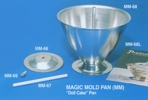
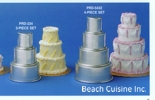   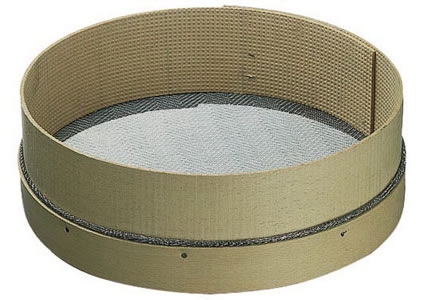 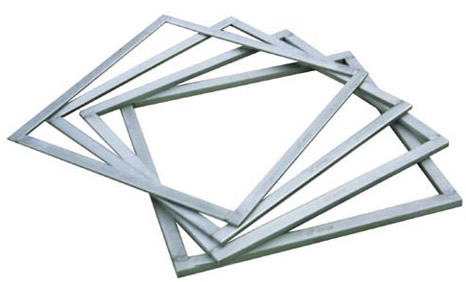
|
||
| We Are Direct Distributors for These Companies | ||
All rights reserved.
Copyright is held by Renee Shelton, Beach Cuisine Inc, or by respective owners.
|
|

